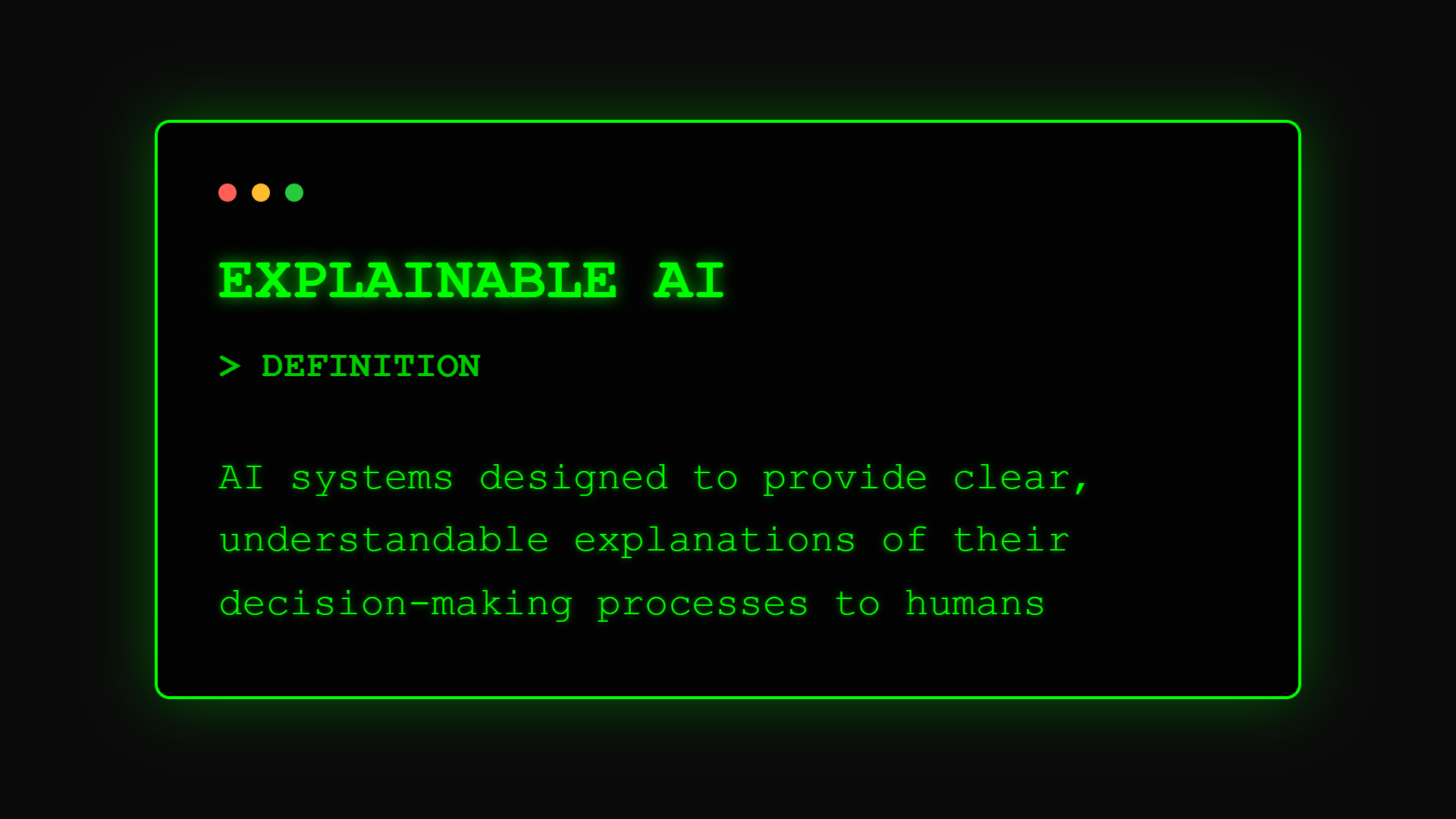AI Terms
What is Explainable AI? When AI Shows Its Work

Your AI just denied a million-dollar loan application. The customer wants to know why. Regulators demand an explanation. Your team needs to verify it made the right decision. This is where Explainable AI becomes critical – transforming AI from a mysterious black box into a transparent partner.
Technical Definition
Explainable AI (XAI) refers to methods and techniques that make the behavior and predictions of artificial intelligence systems understandable to humans. It encompasses tools that reveal how AI models arrive at decisions, which factors influence outcomes, and why certain predictions are made.
According to DARPA, which launched a major XAI program, "Explainable AI will create a suite of machine learning techniques that produce more explainable models while maintaining high performance, and enable users to understand, trust, and effectively manage AI systems."
XAI emerged as AI models became increasingly complex, with deep learning creating powerful but opaque systems that even their creators couldn't fully interpret.
Business Value
For business leaders, Explainable AI transforms AI from an inscrutable oracle into a transparent advisor – enabling regulatory compliance, building customer trust, and providing insights that improve both AI and human decision-making.
Think of XAI like having an expert consultant who not only gives recommendations but explains their reasoning. Just as you wouldn't follow advice without understanding why, XAI ensures you can trust and verify AI decisions.
In practical terms, XAI means your loan officers can explain credit decisions to customers, your doctors can understand AI diagnoses, and your compliance team can audit AI behavior for bias or errors.
Core Components
Explainable AI encompasses:
• Feature Importance: Understanding which inputs most influence AI decisions – like knowing income matters more than age for credit decisions
• Decision Paths: Tracing how AI reached specific conclusions – showing the logical steps from input to output
• Counterfactual Reasoning: Understanding what would need to change for different outcomes – "If income were $10k higher, loan would be approved"
• Model Behavior: Global understanding of how the AI system operates across all decisions, not just individual cases
• Uncertainty Quantification: Knowing when AI is confident versus uncertain, helping humans know when to trust automated decisions
Types of Explainability
Different approaches for different needs:
Global Explanations: Understanding overall model behavior – "This model prioritizes payment history over current income"
Local Explanations: Explaining individual predictions – "This specific loan was denied due to high debt-to-income ratio"
Example-Based: Showing similar cases – "Here are five similar applications and their outcomes"
Contrastive Explanations: Highlighting differences – "Unlike approved applications, this one has irregular payment patterns"
Each type serves different stakeholders and use cases.
XAI Techniques
Major explainability methods:
Technique 1: LIME (Local Interpretable Model-Agnostic Explanations) How it works: Explains individual predictions Best for: Any model type Example: Why a specific customer churned
Technique 2: SHAP (SHapley Additive exPlanations) How it works: Game theory-based feature importance Best for: Complex models Example: Credit risk factor analysis
Technique 3: Decision Trees How it works: Inherently interpretable structure Best for: Regulated industries Example: Medical diagnosis paths
Technique 4: Attention Visualization How it works: Shows what AI "looks at" Best for: Image and text analysis Example: Medical scan interpretation
Real-World XAI
Companies benefiting from explainability:
Financial Services Example: Bank of America's mortgage AI provides detailed explanations for each decision, reducing complaint resolution time by 40% and increasing customer satisfaction while maintaining regulatory compliance.
Healthcare Example: IBM Watson for Oncology shows oncologists exactly which medical literature and patient factors influenced treatment recommendations, increasing physician adoption from 20% to 75% through enhanced trust.
Insurance Example: Lemonade's claims AI explains claim decisions in plain language, reducing disputes by 30% and enabling faster resolution while maintaining fraud detection accuracy.
Explainability Requirements
Different contexts demand different levels:
Regulatory Compliance:
- GDPR's "right to explanation"
- US fair lending laws
- Healthcare decision transparency
- Insurance rate justification
Business Needs:
- Customer trust building
- Employee adoption
- Model improvement
- Risk management
Technical Requirements:
- Real-time explanation generation
- Multiple stakeholder views
- Accuracy preservation
- Scalability
Implementation Challenges
Common obstacles and solutions:
• Performance Tradeoff: Explainable models may be less accurate → Solution: Hybrid approaches balancing both needs
• Complexity Paradox: Explanations can be too complex → Solution: Layered explanations for different audiences
• Explanation Quality: Poor explanations worse than none → Solution: User testing and iterative improvement
• Computational Cost: Explanations slow down AI → Solution: Pre-computed explanations for common cases
Building Explainable AI
Your path to transparent AI:
- Understand AI Ethics driving explainability needs
- Address Bias in AI through transparent models
- Implement AI Governance requiring explainability
- Read our XAI Implementation Guide
Part of the [AI Terms Collection]. Last updated: 2025-01-11